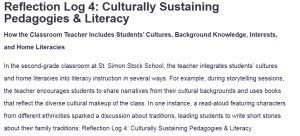Reflection Log 4: Culturally Sustaining Pedagogies & Literacy
How the Classroom Teacher Includes Students’ Cultures, Background Knowledge, Interests, and Home Literacies
In the second-grade classroom at St. Simon Stock School, the teacher integrates students’ cultures and home literacies into literacy instruction in several ways. For example, during storytelling sessions, the teacher encourages students to share narratives from their cultural backgrounds and uses books that reflect the diverse cultural makeup of the class. In one instance, a read-aloud featuring characters from different ethnicities sparked a discussion about traditions, leading students to write short stories about their family traditions: Reflection Log 4: Culturally Sustaining Pedagogies & Literacy.
What Works Well
This approach aligns with the principles of culturally sustaining pedagogy outlined by Souto-Manning and Martell (2016). Multicultural texts and family engagement help validate students’ identities and foster a sense of belonging in the classroom—the teacher’s effort to connect academic content with students’ experiences. Incorporating students’ home literacies into lessons can enhance engagement and comprehension (Zucker et al., 2021). Using culturally relevant materials and encouraging students to share their stories, the teacher creates a literacy-rich environment where all students feel included and valued. This method promotes equity and nurtures students’ ability to relate personal experiences to academic concepts (Guenther & Abbott, 2024).
What Could Be Added or Done Differently?
The classroom could incorporate more peer-collaborative activities like “think-pair-share” (Guenther & Abbott, 2024). This would allow students to discuss their cultural and literacy experiences with their peers before sharing them with the entire class, ensuring every student has an opportunity to participate. Additionally, the teacher could diversify the literacy materials to include texts in students’ home languages.
Reflection on Future Classroom Practices
I plan to create a similar culturally responsive literacy environment by incorporating interactive storytelling sessions where students share personal experiences linked to the themes of the texts we read. I will also establish a rotating “Cultural Book of the Week” that features stories from around the world, allowing students to learn about each other’s backgrounds. I intend to use interactive questioning strategies like those outlined in Reflection Log 2, encouraging students to compare the stories they read to their own lives.
References
Guenther, A. R., & Abbott, C. M. (2024). Think-pair-share: Promoting equitable participation and in-depth discussion. PRiMER: Peer-Reviewed Reports in Medical Education Research, 8.
Souto-Manning, M., & Martell, J. (2016). Reading, writing, and talk: Inclusive teaching strategies for diverse learners, K–2. Teachers College Press.
Zucker, T. A., Cabell, S. Q., & Pico, D. L. (2021). Going nuts for words: Recommendations for teaching young students academic vocabulary. The Reading Teacher, 74(5), 581-594. https://doi.org/10.1002/trtr.1967
ORDER A PLAGIARISM-FREE PAPER HERE
We’ll write everything from scratch
Question 
Reflection Log 4 Topic: (Culturally Sustaining Pedagogies & Literacy) Discuss the ways in which the classroom teacher/s include children’s cultures, background knowledge, interests, and home literacies in literacy instruction. Focus on specific examples. Then, answer the following questions using pertinent readings from sessions 1, 2, and/or 3 to evaluate the extent to which the classroom teacher/s include children’s cultures, background knowledge, interests, and home literacies in literacy instruction:

Reflection Log 4: Culturally Sustaining Pedagogies & Literacy
- What do you notice works well? Explain why.
- What do you think could be added and/or done differently? Explain why.
- Reflect on how you would do this in your class or in the future. Be specific.
